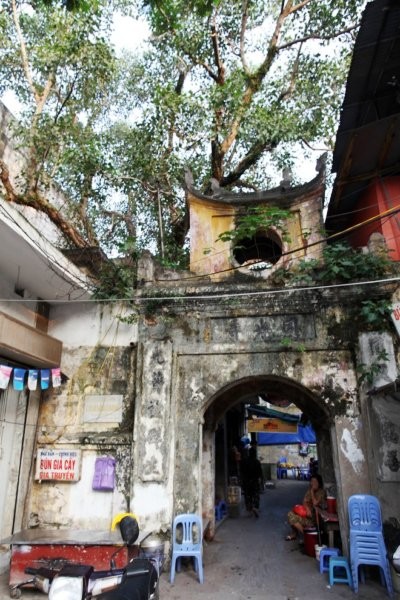Through the three-way gate, visitors enter a narrow alley about fifty steps to Dong Quang pagoda. Until 1975, there were few houses here. From the pagoda, Trung Liet Temple could be clearly seen on the hill on the other side of the street.
The pagoda and the shrine are two spiritual architectural works built in the mid-19th century, located in the relic complex on the heroic Dong Da battlefield. After opening a large road from Hanoi to Ha Dong and filling the lake between these two works, the cluster of relics was divided.
The pagoda was built later, facing southwest. The original architecture consisted of only one Buddhist house built in the shape of the word “Ding”, including the front hall and the upper hall located on the high ground. Later on, it was gradually expanded to include the Ancestral Church in the back and the tomb tower garden on the left of the upper palace. Now, the gate has been encroached on by people’s houses and completely sealed off the front yard, leaving only traces of a few pillars and screens; If you want to go in and out of the temple, you have to go through the alleyway connecting the alley to the backyard.
 |
| The three-way gate of Dong Quang pagoda (Photo: NC) |
The entire Dong Quang pagoda has been continuously overhauled and has its columns and roof raised. The tomb tower garden has also been rebuilt, mainly using gray stone materials. All three front, middle and back yards are tiled, but the area is narrower. The front yard has many green trees highlighting the white stone statue of Avalokitesvara Bodhisattva. The house has 5 compartments on the front street, the roof is covered with tigers and lotus flowers, and the stone steps have dragons on both sides.
The upper hall consists of 3 vertical compartments, trusses stacked with gongs, gong racks, and gradually raised pedestals to decorate Buddha statues. The floor of the pagoda is tiled with square tiles and is exalted quite high compared to the courtyard. Renovating the entire two parallel churches in the north of the tomb tower garden, renovating the front house of the self-danger and repairing the Ancestral and Nun houses. As for the back house of the lute, it has long been transformed into a Mother Church, now there are a lot of female followers and disciples.
Previously, Dong Quang Pagoda had 37 Buddha statues, later added 14 more in the Mother Church and 4 in the worshiping hall of King Quang Trung. In addition, there are 7 hammocks painted with gold paint, 5 altars, 14 stone steles and 2 bronze bells.
Recently, a large wooden set of thousands of eyes and thousand hands Quan Yin statues have been placed in the front house of the lute and stone statues in the space between the compartments in the north of the tomb tower garden, and added decorations to all the altars. .
Excluding the newly brought statues and sacrifices, most of the antiques in the temple are dated to the Nguyen Dynasty. Decorative arts are shown in the con Ruong, the first lines and the first sentences according to the themes of tiger and leaf dragon, leaf clouds, cloud veins, roof fringes with bougainvillea, apricot tree, old bamboo. Two armpits because the middle is embossed with a dragon hidden in the clouds, belonging to the art style of woodcarving of the 20th century…
Source: Collected internet.